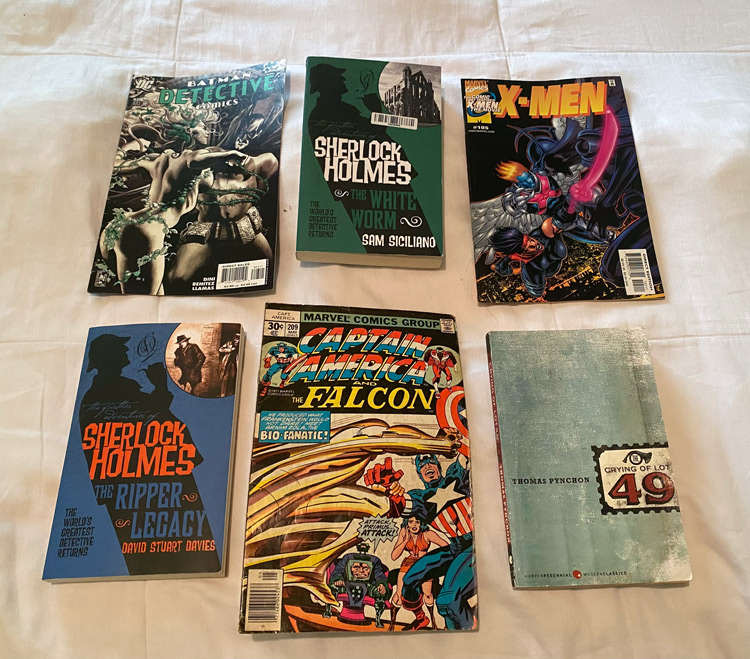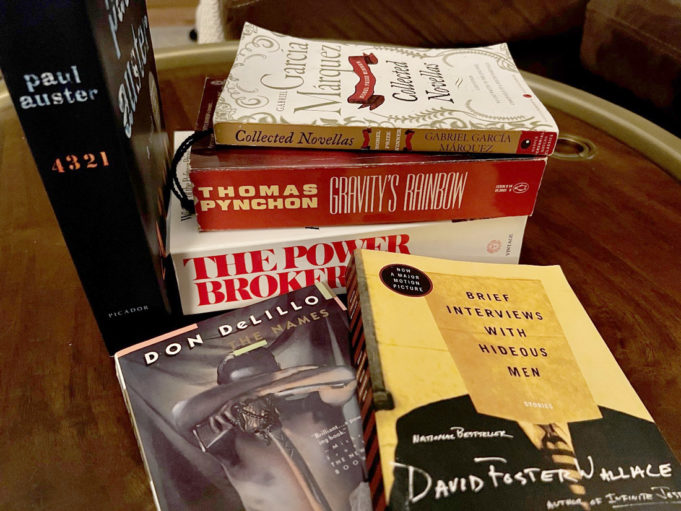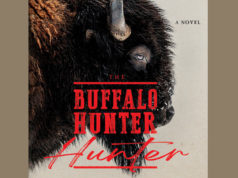For the most part, summer is a great time to catch up on reading. There’s no Game of Thrones or other bingeable TV or even good sports to distract, speaking generally (this NBA/NHL postseason not included). So, fittingly, I asked all my writers what they’re reading now or are planning to soon, and while I neglected to include “free beer!” in the subject line, which usually piques their interest like toddlers passing an open iPad screen, about a handful actually responded. Excuse me. Just had to catch my breath. And so … — Anthony Mariani

Photo by Anthony Mariani.
Pulp Fictions
A comic or five always brighten up my reading queue. I’m revisiting a bunch from the Bronze Age, when I first started collecting, and a few from the late 1990s/early aughts, when I returned to the medium after decades away, specifically X-Men and Batman Detective Comics. My favorites so far have been some Jack Kirby Captain Americas from the mid-to-late 1970s. So wild and corny. My wife and I have been reading them before bed, and we’ve been rattling our heads, sighing, and giggling at the same time. One villain travels by motorized hang glider. I can just see a bunch of ’70s people back then, wearing their loud polyester suits, chain-smoking Camels indoors, telling off-color jokes, thinking, “Hang gliders. This, this is the wave of the future.” Ah *snnnfffff, cough*, the ’70s.
We kicked off our Bronze Age Kirby excursion with a couple Caps I had inherited from my older brother back in the day. I had only merely thumbed through them over the years because I hated “King” Kirby’s ultra-stylized, hyper-modern, patently unrealistic art. Real people didn’t have fleshy cinderblocks for hands. Real people didn’t have one, big, perfect row of a tooth instead of individual teeth. Real people didn’t have perfectly arched backs. It was only after I started drawing my own fantastical tableaux that I realized Kirby’s genius — see his covers to The Eternals for starters — and thought to give him a second chance. I’m glad I did. From a singular artistic standpoint as much as a literary one, corniness and all.
Cap on his own, his cool-to-a-10-year-old uniform notwithstanding, never interested me. He’s a fully grown Boy Scout with super-strength and -speed. Yawn. And the promise of science fiction always intrigued me more than what appeared onscreen or between the covers — Star Wars *annoyed talk to the hand*, 2001: A Space Odyssey *smiling thumbs up*. But put Captain America and sci-fi together like Kirby has, and magic happens.
The main Kirby/Cap storyline we’re following involves (a’hem): a mad scientist concocting otherworldly creatures in his lab to capture our hero and transplant Adolf Hitler’s brain (still pumping on, hanging out in formaldehyde) into Cap’s body while also reconstructing Cap’s square-jawed face and blond head to resemble the Fuhrer’s. I haven’t been this addicted to a ridiculous, ridiculously Awesome-with-a-capital-A plot since Season 6 of GoT.
I sneak in reading when I can, when I’m not doomscrolling, mostly in the “office” (the bathroom) and in my car waiting to pick up my kid from school. And in ye olde 2008 Ford Escape is where I’ve been chipping away at a few book-books, least lacklustrously (should be a word) a 1966 novella. Still traditionally Pynchonian, The Crying of Lot 49 comes across a lot more clear-eyed than the greatest living writer’s National Book Award-winning Gravity’s Rainbow and my favorite Pynchon novel if not my favorite literary text of all time, Against the Day, another 20-pounder and a correction of sorts to Gravity. (Against/Day has a bona fide ending, for one thing, and it’s powerful.) Lot 49 simply romps. Young Oedipa Maas wakes up to her going-nowhere marriage to an ephebophilic radio DJ before pinballing through the weird but surprisingly harmless underground of several fictional L.A. ’burbs circa the mid 1960s, drawn forward by a wild conspiracy about: a deceased real estate mogul’s estate, a secret postal service, the mob, a Jacobean revenge play, a psychic machine, a support group for broken hearts, and, finally and really not that importantly, the (fictional but deliciously named) teenage rock band The Paranoids. Pynchon’s narrative legerdemain and syntactical poetry take flight as brilliantly as usual. The chief distinctions: The Lot story unwinds linearly and maintains only one POV (Oedipa’s). You’ll rip-roar through it.
Now, for a word on pulp. We’re apparently not allowed to consume it anymore because doing so means we’re scared — of the end of capitalism, of the end of democracy, of the end of the planet — and we need to be braver and choke down some Franzen or Zadie Smith or DFW or military history to broaden our meager horizons and face our assorted deaths head on. Hard pass. Just let me and my cocoon of fun, slightly creepy, totally mysterious, easily digestible stories with tidy, happy endings be. There’s nothing better than getting under the covers after a long day of doing whatever it is I do and swiping to some pure pulp on my trusty iPhone 10 (cellphones — also bad for you, also don’t care).
My reader app groans with pulpy novels, pulpy short story collections (Poe, Dickens, Spooky New England), and one super-pulpy series. Written by a rotating stable of contemporary mystery authors, The Further Adventures of Sherlock Holmes features mostly new takes on old Holmesian yarns plus some scrumptious pop-culture-infused T-R-A-S-H. Holmes and Dracula, Holmes and Dr. Jekyll/Mr. Hyde, Holmes and the War of the Worlds, Holmes and the Ectoplasmic Man, Holmes and the Titanic, Holmes and Jack the Ripper — my wife and I have read them all. And have loved every trashy-ass word.
After recently finishing the comparatively tame Cornwall Mermaid (co-starring Holmes’ daughter Lucy James), the wifey and I will soon move onto The Devil and the Four. That’s after we find out if Captain America becomes a reanimated Nazi leader. Insert: political joke circa 2024. — Anthony Mariani
Patrick’s Pile
I suppose the biggest takeaway from my daunting stack of tomes is that my taste in books (and in music, movies, TV shows, and clothing — as well as my general worldview and maturity level) was obviously arrested sometime around 2005. These selections prove that I’ve been kicking around the dusty bibliographies of the same handful of postmodern and post-postmodern writers since my late-night Denny’s coffee- and cigarette-fueled pseudo-intellectual “phase” in high school. A troubling social media addiction has probably robbed me of 15 years or so of time I would (should) have otherwise spent reading actual books instead of skimming through vaguely racist posts from idiots I went to high school with, but the silver lining is that those lost years have left me with plenty of material from my comfort-zone writers still left to plow through.
I’m currently through two of the three novellas included in a Gabriel García Márquez collection that I’ve chosen as a light treat of a read after an especially lengthy Jonathan Franzen novel. I find I follow this pattern in book selection. Like an inverse of my approach to dieting in which I’ll start the day with a nice, small, light meal for lunch, then around dinnertime consume enough food for three full grown men, I’ll typically reach for a 150-pager after conquering a big, fat book approaching 1,000.
In honesty, the Márquez had been my planned palate cleanser after finishing The Power Broker, Robert Caro’s Pulitzer Prize-winning biography of New York development mogul Robert Moses which I thought I could hang with. I was moved to tackle that density by a group of local musicians who’ve started a book club around reading it together, but their investment is on a level I just can’t compete with. So, it sits with the receipt of its purchase as a bookmark just 100 pages in, taunting me for my lack of discipline.
As does Gravity’s Rainbow, which Weekly Editor Anthony Mariani suggests I drop in favor of a staunchly similar yet superior (in his opinion) Pynchon work, Against the Day. Yet Gravity is on all of these pride-challenging “How Many of These Great American Novels Have You Read?” lists, and I value a well-read, scholarly perception among my peers above all else, so I’m going to get to it. Someday.
Anthony also can’t comprehend my love for David Foster Wallace, whose infinite run-on sentences still influence me (as Anthony can certainly attest) and whose Brief Interviews with Hideous Men has somehow escaped me, therefore it’s probably next in the queue.
I look forward to DeLillo’s The Names because I’ll be going into it cold. I have no idea what it’s about and won’t before I begin it. He’s one of my most favorite writers. His prose is so lyrical yet unflamboyant that the narrative is often secondary to the words he uses to progress it.
Paul Auster was a love that was passed around our circle during that pseudo-intellectual phase in the early aughts. I’d mostly forgotten about him until his death last month brought him from the recesses of my addled memory. His novel Moon Palace is one of my very favorite books of all time. Like the DeLillo, I’ll be going into 4321 cold, but if literally every other thing of Auster’s I’ve ever read is any indication, the main character will find himself homeless and living in a dumpster at some point, as Auster himself did in the 1970s in New York City. Though he uses it probably too often, his perspective on that life is always utterly fascinating. — Patrick Higgins
Definitely Not Colleen Hoover
Where do we go when our reality feels like too much to bear? Back to when times were even worse, of course. I do a lot of my reading on vacation (or en route to a vacation) and find that escaping my day-to-day pairs well with an escape into historical fiction. After devouring Anthony Doerr’s epic All the Light We Cannot See on my way to and from Portugal last summer, I went down a rabbit hole of World War II-set novels of varying quality. Being reminded of how Europe was absolutely ravaged by the two world wars is a good way to feel better about ostensibly living in the country from the Handmaid’s Tale.
Two of my favorite World War-set reads of late are Life After Life by Kate Atkinson, which has a science-fiction bent to it as the central character keeps dying and being reborn in the same bleak era of the early 20th century, and Kristin Hannah’s The Nightingale, which follows two sisters living very different lives in Nazi-occupied France. While not the most high-brow literature, I’ve been impressed with Hannah’s ability to write books in a wide range of time periods, and I always learn something. Up next for me is her The Women, about a group of female nurses serving in the Vietnam War.
A guilty-pleasure author of mine is Liane Moriarty. Most famous for Big Little Lies, which was turned into an acclaimed HBO miniseries, Moriarty’s novels are set in Suburban Australia and almost always have a bit of mystery to them, which I’m a sucker for. Again, not something you’re going to be discussing in college English courses, but they’re a step up from the standard beach-read fare. (You’ll not catch me reading a Colleen Hoover book this summer, is all I’m saying.) I would recommend throwing The Husband’s Secret, about a woman whose seemingly perfect marriage is rocked by a letter her husband wrote and instructed her to read only after his death, into your beach bag as I recently read it’s getting the adaptation treatment, too, with Blake Lively starring. — Emmy Smith
Celluloid Pages
One of the great things about being a film critic is that it forces me to keep reading. I’m constantly raiding the local library for novels, short stories, plays, graphic novels, and even the occasional epic poem whose movie versions are due out. Right now, this means I’m working my way through A.M. Shine’s The Watchers, a horror novel about a woman who becomes lost in the forests of Ireland and finds that the only refuge from the beasts that live there is a sealed modern furnished room that is unaccountably in the middle of the woods. It feels like exactly the sort of thing that would appeal to the daughter of M. Night Shyamalan, who is directing the movie.
I’ve also started on Rachel Yoder’s Nightbitch, about an overworked and frustrated mother who mysteriously starts transforming into a wild animal. It’s maybe the angriest piece of female fiction I’ve ever read, and I can’t get enough. That movie is slated for Christmas.
I do occasionally read for pleasure or when I have trouble sleeping at night. The book serving that purpose right now is Cait Murphy’s Crazy ’08, a chronicle of the wacky 1908 baseball season that not only tells of the Chicago Cubs’ World Series triumph that year but also delves into related subjects such as the number of deaf major league players at the time, the City Beautiful architectural movement and its effect on stadium construction, and the pitcher nicknamed “Slothful Bill” Lattimore, whose big-league career lasted all of four games for the Cleveland Naps (now Guardians). Athletes today don’t have nicknames that colorful or insulting. — Kristian Lin
Happy Travels!
Summer’s the time for traveling, and here are a few books on my end table that could transport you.
Local author Heath Dollar’s book of short stories Old Country Fiddle takes you to his fictional Waylon County, a rural Texas locale populated by Czech descendants and real characters, all lovingly portrayed. My favorites include the wonderfully titled “Honkytonking with Silver Strings,” “A Psychobilly Prayer,” and “The Angel, the Devil, and Saint Nicholas.” These and other stories rummaged around my brain long after I put the book down the first time I read it.
Dollar’s one of the best Texas writers around, but don’t take my word for it. The Texas Institute of Letters named Old Country Fiddle the Best Book of Fiction in 2021. I’m hoping next summer I can include his much-anticipated novel on my 2025 summer reading list.
Another book I’m anxious to dive into this summer is about as far away from rural Texas as possible, the late Brooklynite Paul Auster’s New York Trilogy. I’m just now finishing his Baumgartner, a fine novel about a widower some years after his wife has passed. It is by turns hilarious and tear-inducing, sometimes on the same page. Auster’s one of those writers who knows how to get you hooked from the start. In The City of Glass, the first in the trilogy, he begins, “It was a wrong number that started it, the telephone ringing three times in the dead of night and the voice on the other end asking for someone he was not.”
If you’re up for a little time-traveling to 19th-century Russia, check out another title on my end table. I’ve plowed through about half of Dostoevsky’s The Idiot and found the payback more than worth it. Prince Myshkin, the idiot of the title, returns to his native Russia to find everyone obsessed with power and money. Hmm …
Myshkin’s not really an idiot, just honest, idealistic, and a bit naïve. Imagine someone like that showing up today. “Idiot” might be the nicest thing people would say about him. — Ken Wheatcroft-Pardue
Let ’Em in or Go?
Besides being glued to social media and constantly doomscrolling, my summer reading progress has been good. It’s only three books I’ve decided to dive into right now, but I’m excited to read them.
I graduated with an English literature degree while writing for the school paper, and I remember how much studying, reading, and writing were involved, especially for my senior seminar, which was my favorite class by far. I decided to reread a few books from those college days and also read a few titles I’ve always planned and wanted to, all fiction.
One of them is by Chinua Achebe. Set in an Ibo village in Nigeria, Things Fall Apart is about a postcolonial clash of cultures during the time of aggressive European missionaries.
The next two books on my list of reads are Kazuo Ishiguro’s Never Let Me Go and Swedish writer John Ajvide Lindqvist’s Let the Right One In. The two novels are different in a few ways but also strikingly similar.
Lindqvist’s book focuses on a man-versus-monster relationship between the two main characters — one, a Swedish boy, and the other, a young girl who’s a vampire.
Ishiguro likes controversial topics, so his man-versus-man novel includes a lot of questioning of humanity and what is human. The Booker Prize-winning author is certainly wild and entertaining. — Juan R. Govea
Reach for the Shards
The first two books on my reading list are for future Weekly reviews (shameless plug). I am in the middle of TCU Press’ The River Nuts by Avrel Seale, a memoir of a man attempting to complete a long, self-sustained river trip after a stroke has left him with major disabilities. So far, it is a great read, and if you find some time, make your way over to TCU Press. No, they aren’t a company that prints frat party flyers. They are a reputable and interesting house.
The second book is from local author Colin Holmes. The Oxygen Farmer is a science-fiction novel set on the moon that involves “a young astronaut, sabotage, murder, and cover-ups.” I am excited to pass some of the impending triple-digit days lost in orbit.
Book 3 is supposed to teach me how not to make a mess of my daughter as she approaches the age when kids start using smartphones and social media. Jonathan Haidt, a public intellectual and psychologist, recently published The Anxious Generation to great reviews. I have heard him speak about his new book on a number of podcasts, and it sounds like the well-reasoned, well-researched vaccine we’ve been hoping for to address the insanity that the online world poses for kids.
Book 4 on my list (where the hell am I going to find the time to read all of this?) is Bret Easton Ellis’ The Shards. The book was first released as a serialized story read by the author and presented as an autobiography on The Bret Easton Ellis Podcast. As a fan of both the American Psycho author and his show, I was enthralled with this when it was first released. This thriller follows Ellis in his final year of high school that is part Euphoria and part Zodiac as the protagonist navigates the L.A. prep school scene while a serial killer stalks him and his friends. An HBO TV adaptation is in the works with director Luca Guadagnino (Challengers, Call Me by Your Name, Suspiria). I am dying to know how the print version stacks up next to the serialized audio version, and summer is the perfect time to find out.
The final title on my list is The Three-Body Problem by Chinese author Cixin Liu and translated by Ken Liu. To be perfectly honest, I don’t really know what this is about. Aliens? Time travel? Who knows. I love film and TV adaptions, and I love going into fiction blind. I don’t even like watching movie trailers when I can avoid them. The novel is a Hugo Award winner, and the Netflix series looks interesting, so I figured I would read the book and then try out the TV show to see how they compare. Given that the Game of Thrones showrunners are heading up Three-Body, it could go either way. — Reese Pierce
In our summertime Screen article, our film critic runs down the big-screen treats awaiting us for the season. Read his recommendations in the Summer Movie Preview article here.












